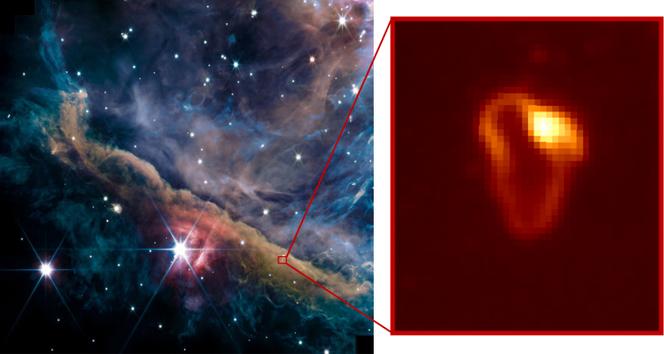


The keen eyes of the James Webb Space Telescope have once again revealed fascinating phenomena at the heart of the formation process of solar systems like our own. An international team has just uncovered an unexpected system, a very early and far-reaching water cycle that could better explain the origin of our planet's water. Observation has revealed that water ice is destroyed and then reformed at an extraordinary rate, in a volume equivalent to the disappearance of a terrestrial ocean every month.
This is not, of course, happening in our Solar System today, but in very young, so-called protoplanetary systems, 1 to 3 million years after the formation of a central star and well before the appearance of telluric planets. More precisely, the events are taking place within the d203-506 disc, already spotted by the Hubble Space Telescope. It is located in the Orion Nebula, the closest star nursery to us, some 1,000 light-years away. But key details, revealed in an article in Nature Astronomy on February 23, had eluded the James-Webb's predecessor.
These details are chemical, even quantum. A molecule, the hydroxyl free radical, made up of an oxygen atom and a hydrogen atom (OH), has been detected for the first time in the zone very close to the central star, less than 100 astronomical units away (three times the distance between the Earth and Neptune), made up of gas and dust. And OH did so in two ways. The first, as if it were spinning on itself at high speed, to the point of almost breaking apart. "It's dizzying," said Benoît Tabone, one of the paper's lead authors from the Institute for Space Astrophysics (IAS) and the French National Center for Scientific Research, who pointed out that this would be the equivalent of a gas heated to over 40,000 degrees (when the environment is already hot, at 10,000 degrees). The second form is more like a vibration of the two atoms, hydrogen and oxygen, which move toward and away from each other, with lower energy.
The telescope's spectroscopic light-scattering cameras are able to detect and, above all, distinguish between these two forms of the hydroxyl radical with different energies. "It wasn't easy because these are very weak signals, which we weren't sure we could 'pick out' from the noise of the instrument," said Marion Zannese, who's completing her thesis at the IAS under the supervision of Emilie Habart, co-leader of this observational project. In addition, theoreticians from the University of Leiden (Netherlands), the University of Salamanca (Spain) and the Madrid Institute of Fundamental Physics were able to explain the origin of these two forms using molecular dynamics calculations, drawing on quantum physics.
You have 47.32% of this article left to read. The rest is for subscribers only.
